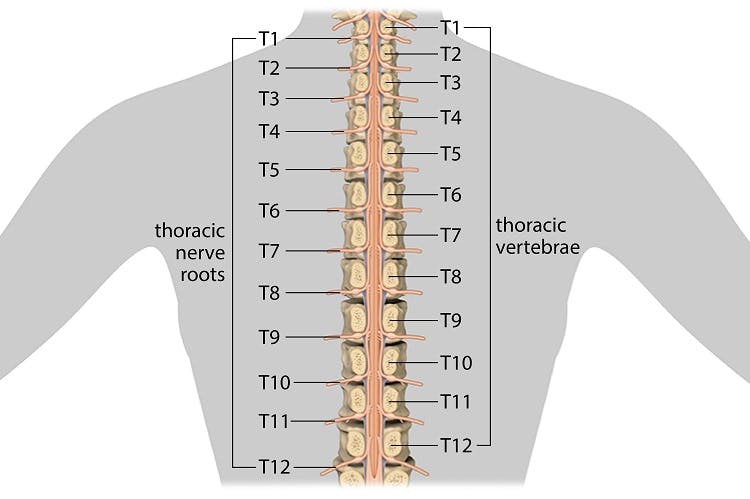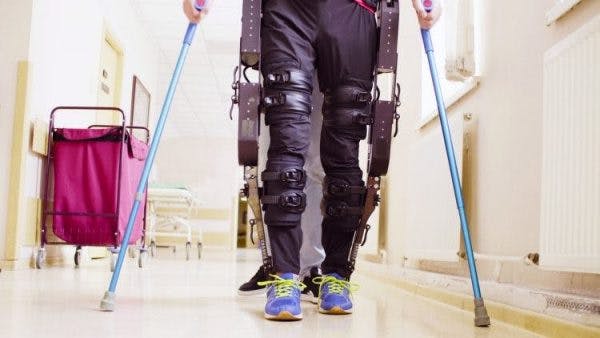Following a thoracic spinal cord injury, individuals experience loss of motor control and sensation in the trunk and/or legs, referred to as paraplegia. Depending on the level and severity of the spinal cord injury, the extent to which motor control and sensation are affected may vary.
Some individuals may only experience weakness and difficulty with coordinating their leg movements, while others may be paralyzed and lose sensation from the trunk down.
To understand more about thoracic spinal cord injury, this article will discuss:
- What is a thoracic spinal cord injury?
- Complete vs incomplete SCI
- Functions affected by thoracic spinal cord injury
- Recovery outlook
- Management strategies
What is a Thoracic Spinal Cord Injury?
The spinal cord is a bundle of nervous tissue that runs through the spine, acting as a connecting pathway between the brain and body. Thirty-one pairs of spinal nerves exit the spinal cord between each vertebra.
Each pair of nerves connects to a different set of muscles for movement and area of skin for sensation. There are 12 nerve pairs within the thoracic spinal cord. Injury to this area is referred to as a T1-T12 spinal cord injury, depending on the level of injury.
The thoracic region of the spinal cord connects to and controls the trunk and inner arm muscles, and relays sensations from skin in these areas. The location of the connected muscles and skin at each respective level of the thoracic spinal cord are closely aligned, falling in very similar areas of the body.
The higher the level of your spinal cord injury, the more functions will be affected. This occurs because signals to and from the brain are not able to pass through the area of damage. Thus, the transmission of messages to and from areas below the level of injury may be disrupted.
Because of this, individuals with thoracic spinal cord injuries may also experience paralysis and a lack of sensation in their lower bodies.
Complete vs Incomplete Thoracic Spinal Cord Injury
Spinal cord injuries can be classified as either complete or incomplete based on their severity.
In complete spinal cord injuries, all neural pathways have been severed at the level of injury, eliminating any communication between the brain and body below the level of injury. This results in a complete loss of motor control and sensation below the injury level.
Conversely, when an incomplete spinal cord injury has occurred, some neural pathways are spared. Depending on how many neural pathways are spared during an incomplete spinal cord injury, some sensory and/or motor signals may still be able to be transmitted below the level of injury. This can allow sensory and motor functions to remain intact or be recovered after injury.
Functions Affected by Thoracic Spinal Cord Injury

The level of the spinal cord injury refers to the lowest portion of the spinal cord in which all sensory and motor functions remain intact. Therefore, if an individual sustained a T1 SCI, the functions controlled by the T1 spinal nerves would remain intact, while sensory and motor functions controlled by each of the spinal nerves below that level could be affected.
In the following sections, we’ll describe what may be affected at each level of thoracic spinal cord injury in 2 general sections: T1-T5 SCIs and T6-T12 SCIs.
T1, T2, T3, T4, and T5 Spinal Cord Injuries
T1-T5 thoracic spinal cord injuries primarily affect the muscles in the upper chest, upper back, and inner arms. As a result, individuals with higher-level thoracic injuries may experience difficulties sitting upright due to a lack of trunk stability.
T1 nerve roots affect sensation in your inner forearm and the ability to spread your fingers apart (finger abduction). T2 nerve roots affect sensation around the armpits and upper chest, as well as the upper chest muscles.
T3, T4, and T5 nerve roots affect sensation in the upper back, as well as the upper, mid, and low chest areas, respectively. For example, a T4 spinal cord injury survivor often experiences motor and/or sensory changes from the mid-chest and down.
The intercostal muscles, which lie in between each rib, are also affected by T3-T5 nerve roots. These muscles are vital for breathing, helping the chest to expand and contract during inhalation and exhalation. Therefore, breathing as well as coughing and sneezing may be more challenging at this level of injury or higher.
Additionally, individuals with T6 or higher level injuries are more likely to experience a condition called autonomic dysreflexia which affects involuntary functions like body temperature regulation, heart rate, and blood pressure. Without proper management, autonomic dysreflexia can be life-threatening. Therefore, it is essential for at-risk individuals to be aware of potential triggers and avoid them.
T6, T7, T8, T9, T10, T11, and T12 Spinal Cord Injures
T6-T12 spinal cord injuries affect sensation and motor control around the trunk and abdominal areas. As a result, motor control and sensation in their arms and chest should not be affected.
T6 nerve roots generally affect sensation around the top of the abdomen, and therefore T6 spinal cord injury survivors often experience changes in motor and sensation from the top of the abdomen and down. Each consecutive set of nerve roots connects to a lower portion of the trunk and abdomen.
Individuals with lower-level thoracic spinal cord injuries generally have enough trunk control that they can sit upright and perform transfers independently.
It’s important to remember that while the level of the SCI provides general information regarding functional outcomes, the severity of the spinal cord injury greatly affects the functional abilities retained following the injury. The affected motor control and sensation of someone with any specific level of SCI can vary significantly, resulting in differing functional abilities.
Recovery Outlook for Thoracic Spinal Cord Injury
Life following a thoracic spinal cord injury may look notably different than before. Methods of recovery can vary. For some, recovery entails retraining the brain and body to communicate as they did before the injury in order to recover lost sensory and motor functions.
On the other hand, others pursue recovery by learning adaptive strategies to compensate for their deficits. Many individuals utilize both recovery tactics to become as independent as possible.
When individuals have a complete spinal cord injury, they likely will not be able to recover lost sensory and motor functions. This is because all communication pathways between the brain and body have been severed. Therefore, their recovery will likely focus primarily on learning to compensate for their deficits.
Due to the presence of spared neural pathways, those who have sustained an incomplete spinal cord injury are able to take advantage of neuroplasticity to recover lost functions.
Neuroplasticity is process by which the spinal cord is able to rewire itself. Through the spinal cord’s adaptive changes, functions affected by damage can be relearned. Since only undamaged neural pathways are capable of utilizing neuroplasticity, those with milder SCIs generally have a better recovery prognosis.
The best way to promote neuroplasticity is to consistently practice affected functions. Highly repetitive movements and sensory input help stimulate the spinal cord and reinforce demand for those functions to promote neurological adaptations. Therefore, rehabilitation following thoracic spinal cord injury often focuses on optimizing neuroplasticity.
Thoracic Spinal Cord Injury Management Strategies

Despite having lower body weakness, paralysis, and/or sensation deficits, many individuals with thoracic spinal cord injuries live independent, active lives.
In the following sections, we’ll go over management interventions that can help you manage your secondary effects and pursue recovery after a thoracic spinal cord injury.
Rehabilitative Therapies
Rehabilitative therapies play an essential role in the spinal cord injury recovery process.
Physical therapy uses targeted exercises to improve motor control, promote sitting balance, maintain range of motion, and stimulate the spinal cord through neuroplasticity.
Occupational therapy empowers individuals to be as functionally independent as possible. This may involve practicing activities of daily living like putting on clothes and performing transfers. Additionally, individuals may learn adaptive techniques to compensate for weakness, paralysis, or lack of sensation of the trunk and/or lower body.
Adaptive Tools and Medical Devices
An occupational therapist may recommend adaptive tools and home modifications to help promote independence after thoracic spinal cord injury. For example, setting up ramps or support bars throughout the house can make it much easier to be independent, especially in a wheelchair. Additionally, those with affected trunk stability following a thoracic SCI may benefit from using a reacher to pick items up without straining or losing their balance.
Other medical devices, such as a customized manual wheelchair, may be recommended by your doctor or therapist.
Learn more about adaptive tools for spinal cord injury »
Mental Health Supports
Following a thoracic spinal cord injury, many individuals may find themselves struggling with their mental health as a result of their circumstances.
Psychotherapy may help individuals learn more effective ways to cope with the changes they are experiencing. Furthermore, many find that joining a spinal cord injury support group is a great way ease the adjustment into life after a spinal cord injury.
Healthy Lifestyles
Pursuing a healthy lifestyle by being physical active, eating a nutritious diet, and keeping a positive mindset can also promote recovery and overall wellness following a thoracic spinal cord injury. Taking steps to manage the secondary effects of your injury can also help to minimize complications and optimize recovery outcomes.
While it is beneficial to participate in rehabilitation early on, focusing on fully engaging in the rehabilitation process is essential for recovery. Consistently practicing exercises during therapy and at home using a home exercise program will help promote adaptive changes in the spinal cord through neuroplasticity to encourage recovery.
Future Treatment Options
New techniques for spinal cord injury recovery are constantly being researched and trialed.
Among the most promising options is a robotic exoskeleton, which would allow even those with high-level complete thoracic spinal cord injuries to walk independently. Although still relatively new, these wearable devices are being used more frequently during rehabilitation with positive results. Furthermore, ways to adapt exoskeletons for personal use at home and in the community are being explored.
Stem cell implantation and electrical stimulation are also being studied as potential techniques to promote recovery.
Understanding Thoracic Spinal Cord Injury
Thoracic spinal cord injuries directly affect movement and sensation in your inner arms, trunk, and abdomen. However, they also affect lower limb functions because messages from the brain cannot always travel past the injury site.
Individuals with thoracic spinal cord injuries are often capable of living independent, fulfilling lives by participating in rehabilitative therapies, maintaining a positive mindset, and making adaptive changes.
We hope this article helped you understand what to expect after a thoracic spinal cord injury.











